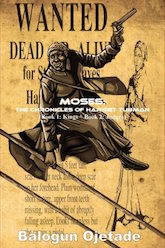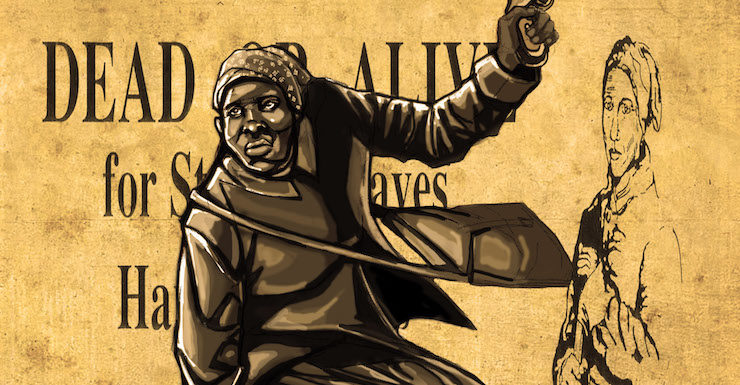In February of 2016, Fantastic Stories of the Imagination published an essay by me called “A Crash Course in the History of Black Science Fiction.” Since then, Tor.com has published my in-depth essays on fifteen of the 42 works mentioned. In this sixteenth column I write about 2011’s steampunk/alternate history/horror novel Moses: The Chronicles of Harriet Tubman (Book 1: Kings and Book 2: Judges), by Balogun Ojetade.
SHORT AND SHARP
 Despite the dauntingly long title, Moses is no interminable historical treatise. It’s a fast-paced adventure, and at 174 pages, a nicely compact paperback with the weight and feel of a fat-spined graphic novel. Ojetade begins the book with heroine Harriet’s single-handed raid on a den of slavers and child abusers, and she barely rests between her numerous other exploits. Battling a body-swapping demon, pursued by an armed battalion of animated mounds of earth, Harriet relies on the “Lawd” to ensure her victory in each new episode she engages in, and counts on her superior, extra-quick healing abilities to prepare her afterwards for the next battle. Like Jesus Christ himself driving moneylenders from the temple precincts, she lays about her with a fierceness born of faith. The author’s experience as a martial arts instructor helps him craft the book’s fight scenes with enviable crispness and clarity: “The web of flesh between Harriet’s thumb and forefinger struck the man’s throat,” he writes at one point. Swift moves follow, step by rapid step: throws and punches and head butts in logical and devastating order. And because feisty Harriet is so easy to root for, outcomes matter, and the story’s frequent bouts of violence never feel gratuitous. She’s fighting evil. We’re on her team.
Despite the dauntingly long title, Moses is no interminable historical treatise. It’s a fast-paced adventure, and at 174 pages, a nicely compact paperback with the weight and feel of a fat-spined graphic novel. Ojetade begins the book with heroine Harriet’s single-handed raid on a den of slavers and child abusers, and she barely rests between her numerous other exploits. Battling a body-swapping demon, pursued by an armed battalion of animated mounds of earth, Harriet relies on the “Lawd” to ensure her victory in each new episode she engages in, and counts on her superior, extra-quick healing abilities to prepare her afterwards for the next battle. Like Jesus Christ himself driving moneylenders from the temple precincts, she lays about her with a fierceness born of faith. The author’s experience as a martial arts instructor helps him craft the book’s fight scenes with enviable crispness and clarity: “The web of flesh between Harriet’s thumb and forefinger struck the man’s throat,” he writes at one point. Swift moves follow, step by rapid step: throws and punches and head butts in logical and devastating order. And because feisty Harriet is so easy to root for, outcomes matter, and the story’s frequent bouts of violence never feel gratuitous. She’s fighting evil. We’re on her team.
WHAT WE’RE FIGHTING FOR
Real-life Harriet Tubman escaped slavery in 1849 only to return to its domain seven times so that she could rescue others. During the Civil War she spied on the Confederate Army. Why? Because she wanted to end the horrors of the South’s “peculiar institution,” horrors easily comparable to Moses’s cannibals and werewolves. When Ojetade’s fictional version of Tubman gets tricked into abducting the hostile United States Secretary of War’s daughter, she flees with her across a postwar landscape still weltering in anti-blackness.
Riding a train along the tracks of an actual under-the-ground railroad, flying in a steam-powered dirigible, Ojetade’s Harriet rallies the forces of righteousness wherever she goes. A churchful of Mexican villagers aim their revolvers at a regiment of ghouls; black pioneer Stagecoach Mary breaks a bad guy’s neck with her bare hands and gut-shoots a rampaging giantess—it’s a wild storyline, and in the end you just know there will be further injustices to defeat, in sequels yet to come. So far, though, there’s just one. It appeared in 2015: The Chronicles of Harriet Tubman: Freedonia, and it relates Harriet’s and Mary’s adventures in a parallel universe.
GETTING SELF-PUBLISHED
When my fellow postcolonialist steampunk Jaymee Goh introduced me to Moses and the wealth of related fiction Ojetade and his cohort have produced—Animist airships! Fugitive pan-African royalty!—my first reaction was anger. Why hadn’t I been told before that this stuff existed? Who had dared to keep my eyes from previously encountering such high-concept rambunctiousness?
Of course, no conspiracy was necessary. I doubt there was one. Traditional publishing’s gatekeepers—these days more often employed in marketing departments than as editors—play it safe when they can. Authors pitching books are expected to describe them in terms of successful predecessors: “It’s Beloved meets The Da Vinci Code!” As weird and twisty as the plot of Moses is, that sort of summary stays out of honest reach. And the book’s unrepentant blackness has made it easy for larger publishers to reject it as a financial risk, a niche entertainment with a small potential audience. This was especially true in the pre-Black Panther era.
So Moses and its current sequel, and the many extant novels and anthologies of the same ilk were published by their authors. I can order them online from the authors’ businesses, Roaring Lions Productions and MV Media, or I can find the authors vending them at conventions and festivals and buy them in person. But the promotion, distribution, and editing traditional publishing is known for were and are completely unavailable to them. This is particularly evident in the books’ lack of copyediting. Thankfully, most of the resulting errors are merely annoying—mistakes on the order of using “it’s” (the contraction of “it is”) in place of “its” (the possessive form of “it”). They hinder but don’t destroy enjoyment of this subgenre’s vivid originality.
STEAMFUNKATEERS ASSEMBLE!
More than a merely literary idea, though, Moses represents a broad aesthetic movement: steamfunk. Think of steamfunk as an African American Vernacular version of steampunk and you won’t be off by much. Ojetade and his co-conspirator Milton Davis came up with the term to describe what they and their fans create: an alternate nineteenth century focused on the accomplishments and exploits of African and Afrodiasporic peoples. As well as steamfunk fiction, there are games, art, costumes, and short films.
Ojetade, Davis, et al. aren’t the only ones coining labels for this sort of thing. Doselle Young has been known to talk about “cotton gin punk,” and I call Everfair, my alternate history of the Belgian Congo, “Afroretrofuturism.” But we’ve both been generously welcomed into the movement, made over anew as “steamfunkateers,” invited to partake in conventions and anthologies and fundraisers celebrating the inventiveness, hard work, and artistic genius of the black roots of the steam era. I’m happy to join in. Maybe you will, too?
 Nisi Shawl is a writer of science fiction and fantasy short stories and a journalist. She is the author of Everfair (Tor Books) and co-author (with Cynthia Ward) of Writing the Other: Bridging Cultural Differences for Successful Fiction. Her short stories have appeared in Asimov’s SF Magazine, Strange Horizons, and numerous other magazines and anthologies.
Nisi Shawl is a writer of science fiction and fantasy short stories and a journalist. She is the author of Everfair (Tor Books) and co-author (with Cynthia Ward) of Writing the Other: Bridging Cultural Differences for Successful Fiction. Her short stories have appeared in Asimov’s SF Magazine, Strange Horizons, and numerous other magazines and anthologies.










